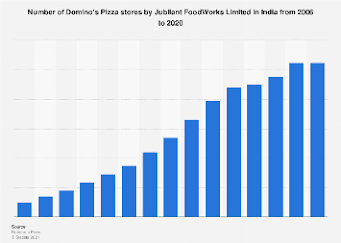How Domino's Won India
- Rohan Nidmarti
- May 17, 2021
- 3 min read
When it comes to pizza in India, Domino's is the clear winner. Domino's entered India in 1995, just when the country was opening up its economy to the rest of the world. Today, Domino's has 1300 stores in India, while it's rivals Pizza Hut and Papa John's have 430 & 66 stores respectively. India's pizza market is worth $1.5 billion, & Domino's has a 70% market share. India is its largest market outside the US.

1) Localisation
India, with it's 1.3 billion people, is a major market for international food chains. Domino's 'Indianised' their menu by adding local taste in their flavours, & catering to the Indian consumers taste. They also retained their Western cool since Indians are willing to pay a premium for that. Pizza innately is a shared item that is eaten utensil-free, two keystones of Indian food-culture. Domino's also hyperlocalized its pizzas by launching a spicy raw banana pizza in South India.
2) Price
Indian consumers are price-sensitive, & have a low disposable income. Domino's spent 8 months examining everything from flour to toppings, to lower prices. It then introduced the 'Pizza Mania', a 99 rupee pizza. Domino's serves it's lowest priced pizza in India, & provides offers and combos at affordable prices.
3) Standardisation
Jubilant FoodWorks holds the master franchise for Domino's in India. In other countries, Domino's has many different store owners that need communication from corporate. In India, corporate communicates only to Jubilant, who execute with complete control. Domino's, for years has maintained quality through standardisation of operations. For example, It has an efficient dough factory in Jalandhar that supplies dough to all retail stores, & cheese is brought in from Karnal.
Domino's uses a hub-and-spoke model, where Delhi is it's prime sourcing base that receives goods from Jalandhar & Karnal, & retail stores are spokes. Vegetables & spices are sourced locally. This efficient supply-chain management has been key to Domino's success.
4) Quick Delivery
The 30-minute-or-free guarantee was the foundation of Domino's Indian business. In 1996, food delivery was a relatively new concept in India, & the guarantee incentivised Indians to try out food ordering since they were assured quick delivery. Thus, Domino's created the food delivery model in India. In order to deliver pizzas quick, Domino's has a standard process, where it takes 4 minutes for dough stretching & topping, 6 minutes for baking, 5 minutes for cutting & packing, & 8 minutes for delivery. This also leaves a 7 minute buffer time.
Domino's riders are required to know every street, pothole, traffic light etc. Outlet locations are chosen in such a way that riders can access the most number of buildings within 10 minutes. Domino's also carries out mock runs during peak traffic hours, & has a 99% success rate with its 30-minute-or-free guarantee.

5) Changing Demographics
India is a mobile-first country, which means many people use phones to access the internet. 86% of Domino's delivery sales happens through online orders. Domino's has emphasised on their app & mobile-ordering flow, & has great social media engagement. They have been dominating social media with 5x the engagement when compared to their rivals.
The pandemic has brought a halt to in-house dining, however, food delivery has risen. In the recent years, there has been a rise in the number of independent households & nuclear families as a result of changing dynamics & family structures. This has led to an increase in non home-cooked food consumption.
Domino's has immense growth potential with great untapped market. Jubilant is now trying to replicate Domino's success in Bangladesh, Nepal, & Sri-Lanka




I shall think about this analysis before ordering a pizza from Domino’s :)